Spectra Logic nTier Verde review
Tape guru Spectra Logic moves into backup and archive disk storage with its affordable nTier Verde appliances.
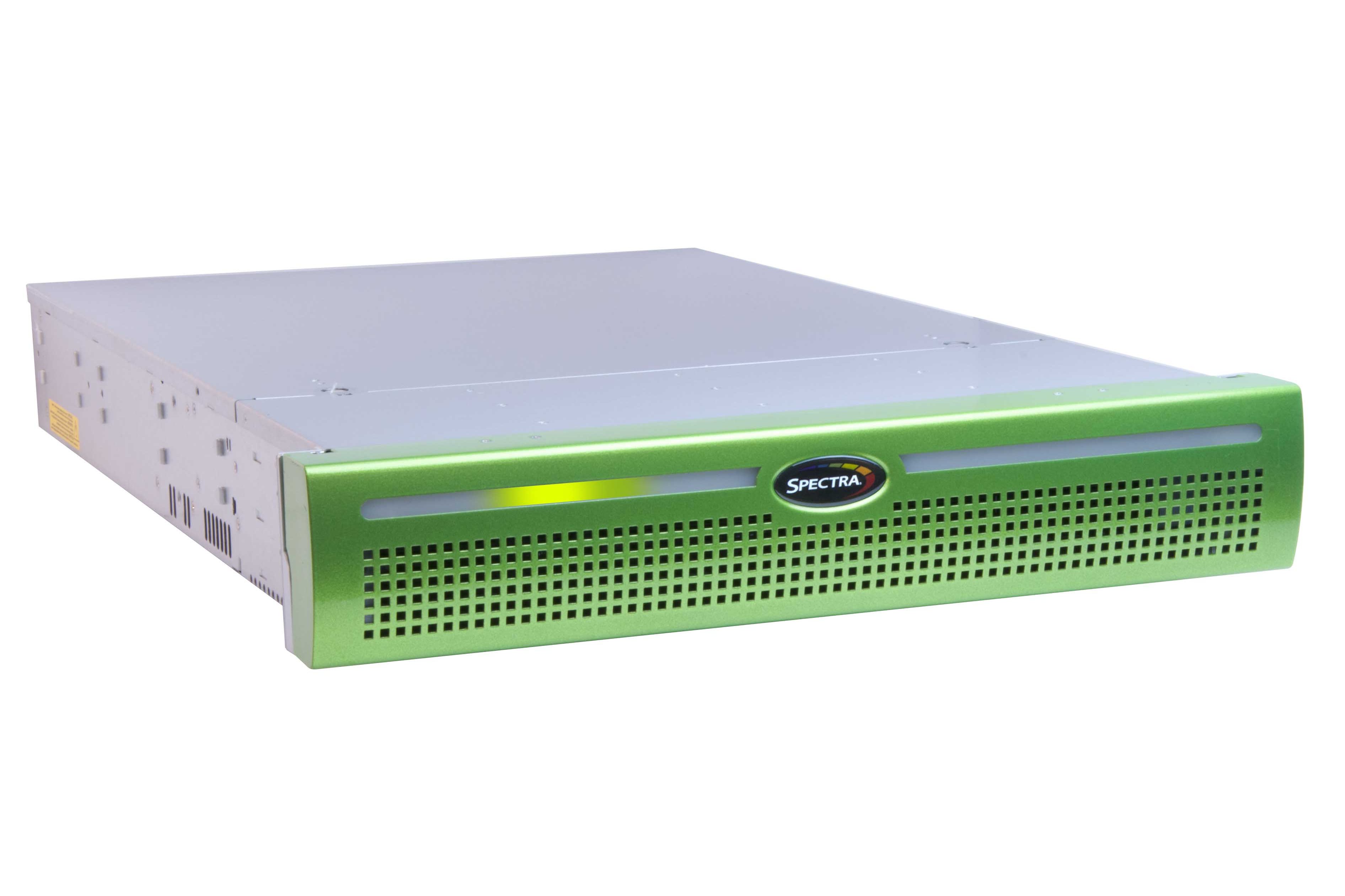
The nTier Verde provides highly fault tolerant shared storage for data archiving and backup at a low price. The 2U model only supports one expansion shelf but storage is easy to provision and CIFS share performance is good.
-
+
Good value; High levels of redundancy; Easy to deploy and provision; Good CIFS share performance
-
-
Supports one expansion shelf; Replication some way in the future

Sales of Spectra Logic tape libraries are strong but this hasn't stopped the firm diversifying into disk storage systems with its nTier Verde range.
These arrays are designed to provide fault tolerant file storage for long-term archiving and backup. No IP SANs here as storage is presented as CIFS and NFS shares only.
The family consists of 2U or 4U master units to which you can add additional disk shelves. The 4U model supports up to nine extra 4U shelves whereas the 2U unit on review only supports one 4U shelf.
Supermicro is behind the hardware with the 2U chassis using a dual socket motherboard with a single 2GHz E5-2620 Xeon and 32GB of DDR3. The drive backplane and integral expander supports up to eleven SAS drives and is cabled directly to one of the motherboard's embedded SAS2 ports.
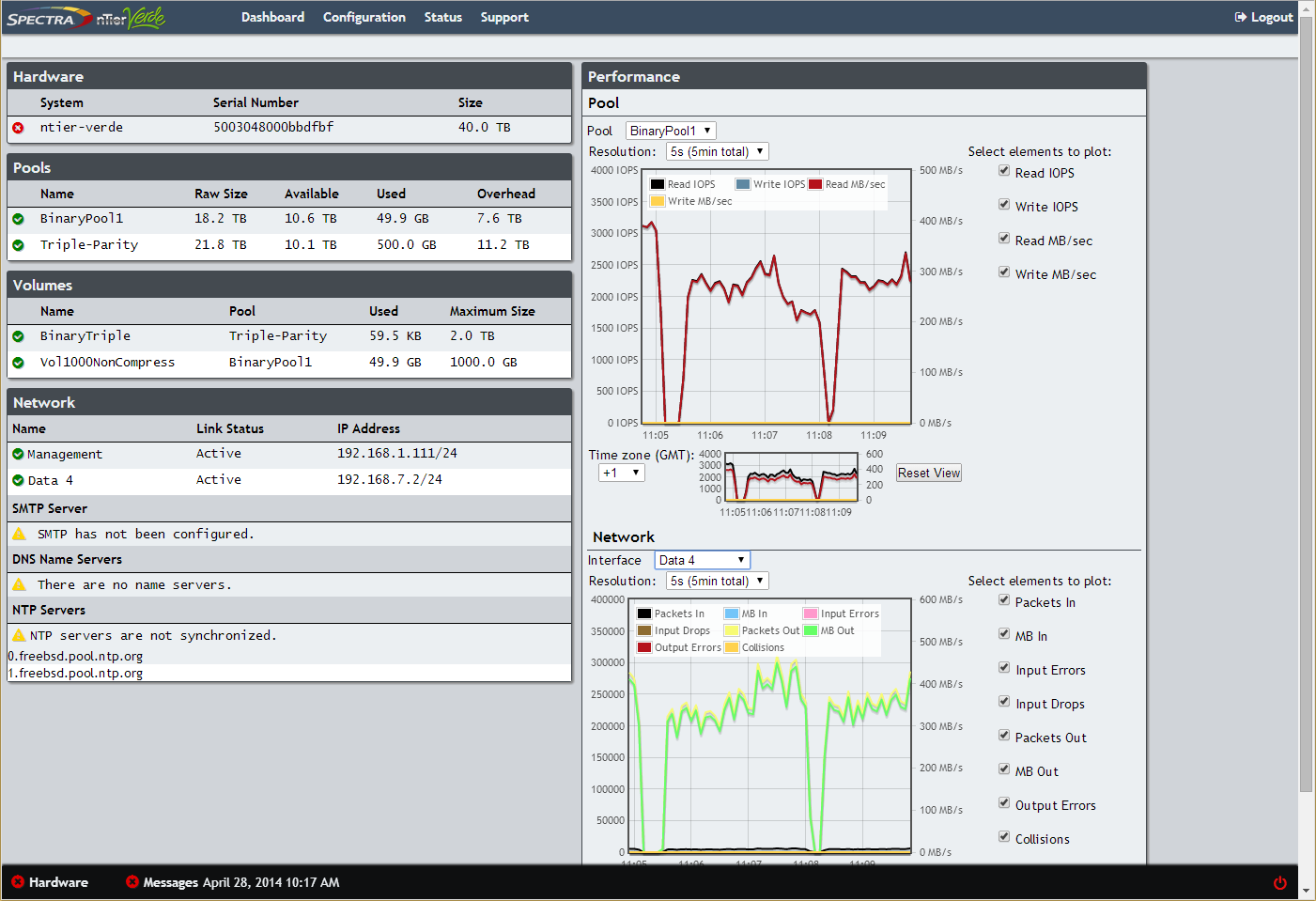
The StrataView web interface provides a detailed Dashboard status view of all storage components
KITT and ports
The upper left drive bay is occupied by Spectra Logic's Visual Status Beacon (VSB) control sled. This plugs into the bezel which provides a flashy Knight Rideresque multi-coloured scanning light bar showing visual system status.
All eleven drive bays are available for data storage duties as the OS is installed on a pair of 250GB mirrored SFF SATA hot-swap drives at the back of the chassis. Spectra Logic scores well for value as the base system with six 4TB 7.2K SAS2 hard disks costs 8,900 ex VAT.
The system has four embedded Gigabit ports with the first dedicated to management duties and the others available for data transfer. We also had the optional dual-port 10GbE card which is installed in one of the PCI-e slots.
You can aggregate the Gigabit or the 10GbE ports into high-speed links with one virtual IP address using DHCP. Using static link aggregation, up to sixteen IP addresses can be assigned to the virtual port's MAC address for higher performance.
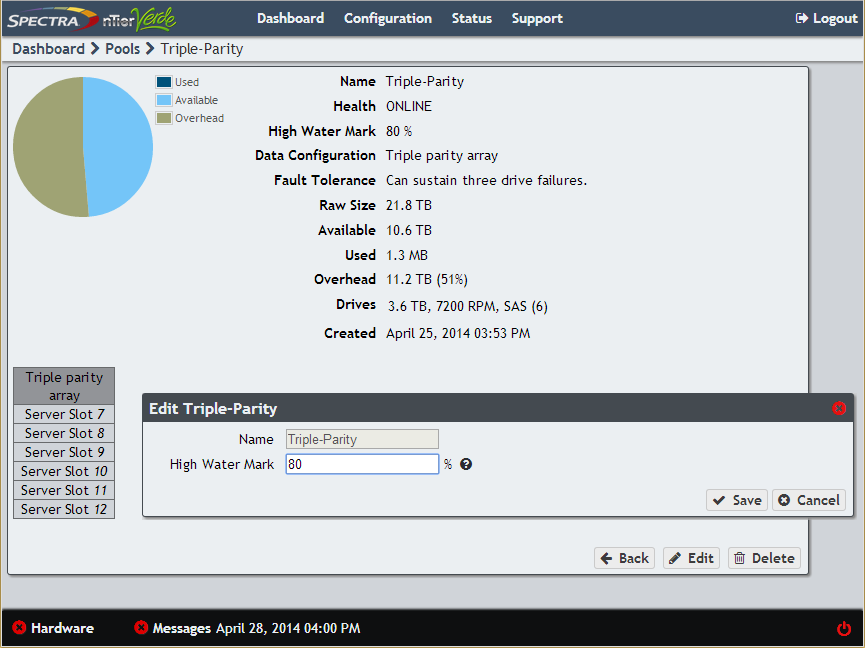
You'll need at least six hard disks if you want triple-parity protection on a drive pool
Provisioning and snapshots
For storage provisioning you start by creating storage pools with selected drives. Along with mirrors or stripes you can opt for single-, double- or triple-parity protection for each pool.
Within a pool you create volumes where you enter minimum and maximum sizes, enable compression and opt for read only or read/write access. The Verde automatically applies thin provisioning and uses the pool's high watermark to warn if space is getting tight. You can select the pool and expand it on the fly into available hard disks.
Creating CIFS shares is simply a case of selecting a volume, providing a name and deciding on read only or read/write access. Shares are only automatically accessible to hosts if the appliance is in an Active Directory domain. If not, you must log each host in using the appliance's local CIFS administrative account.
Volume snapshots are just as easy to create and can be run on-demand on selected volumes or to hourly, daily or weekly schedules. For volume recovery you view its associated snapshots and choose the one you want to rollback to.
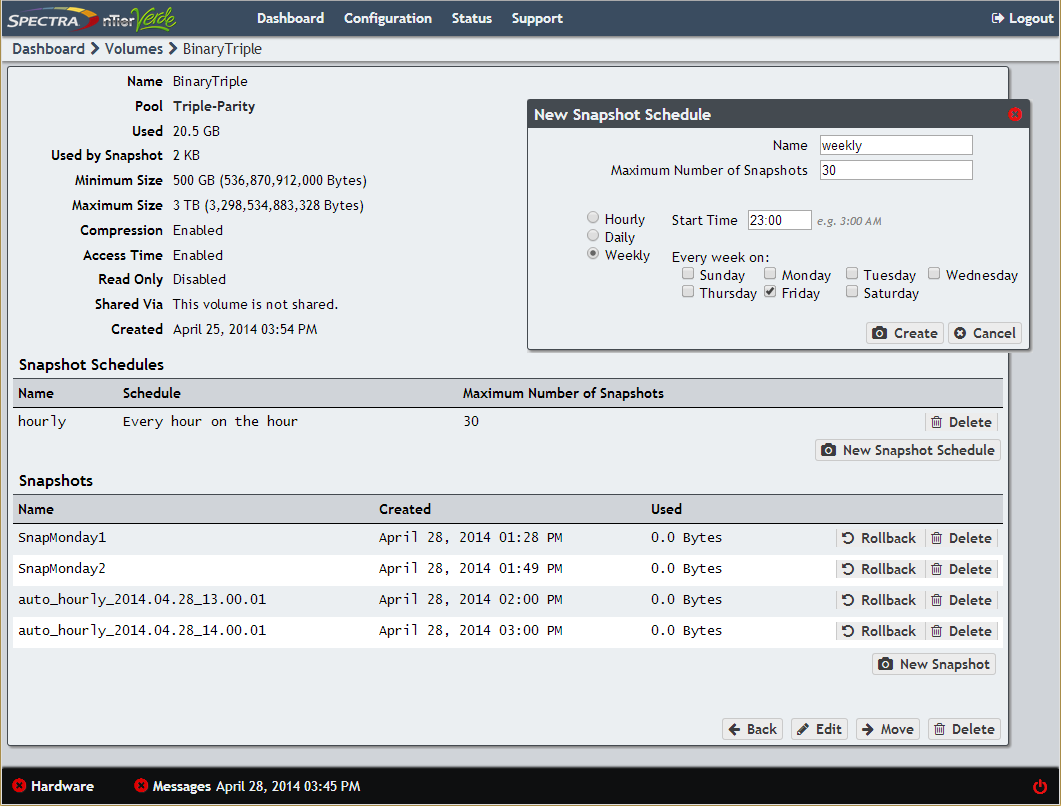
Volume snapshots are included as standard and can be run manually or to a schedule
Performance
For performance testing we created double-parity and tripleparity pools with CIFS shares for each one. For our host system we used a 10GbE-ready Broadberry Data Systems rack server with dual 2.6GHz E5-2670 Xeons, 48GB of DDR3 and Windows Server 2012 R2.
For raw 10GbE performance Spectra Logic advised us it's been seeing 430MB/sec and 390MB/sec read and write performance for a double-parity volume and 340MB/sec and 280MB/sec for a triple-parity volume. Running Iometer on shares in each of our test volumes we recorded similar speeds.
For real world testing we copied our 50GB Iometer test file to and from the shares and saw sustained read and write speeds of 306MB/sec and 265MB/sec for the triple-parity volume. Write speed was similar for the double-parity volume but read speeds increased to 318MB/sec.
To test general backup performance we copied our standard 22.4GB folder and its 10,500 small files to each share. We saw respectable write speeds for the double-parity and triple-parity volumes of 172MB/sec and 165MB/sec.
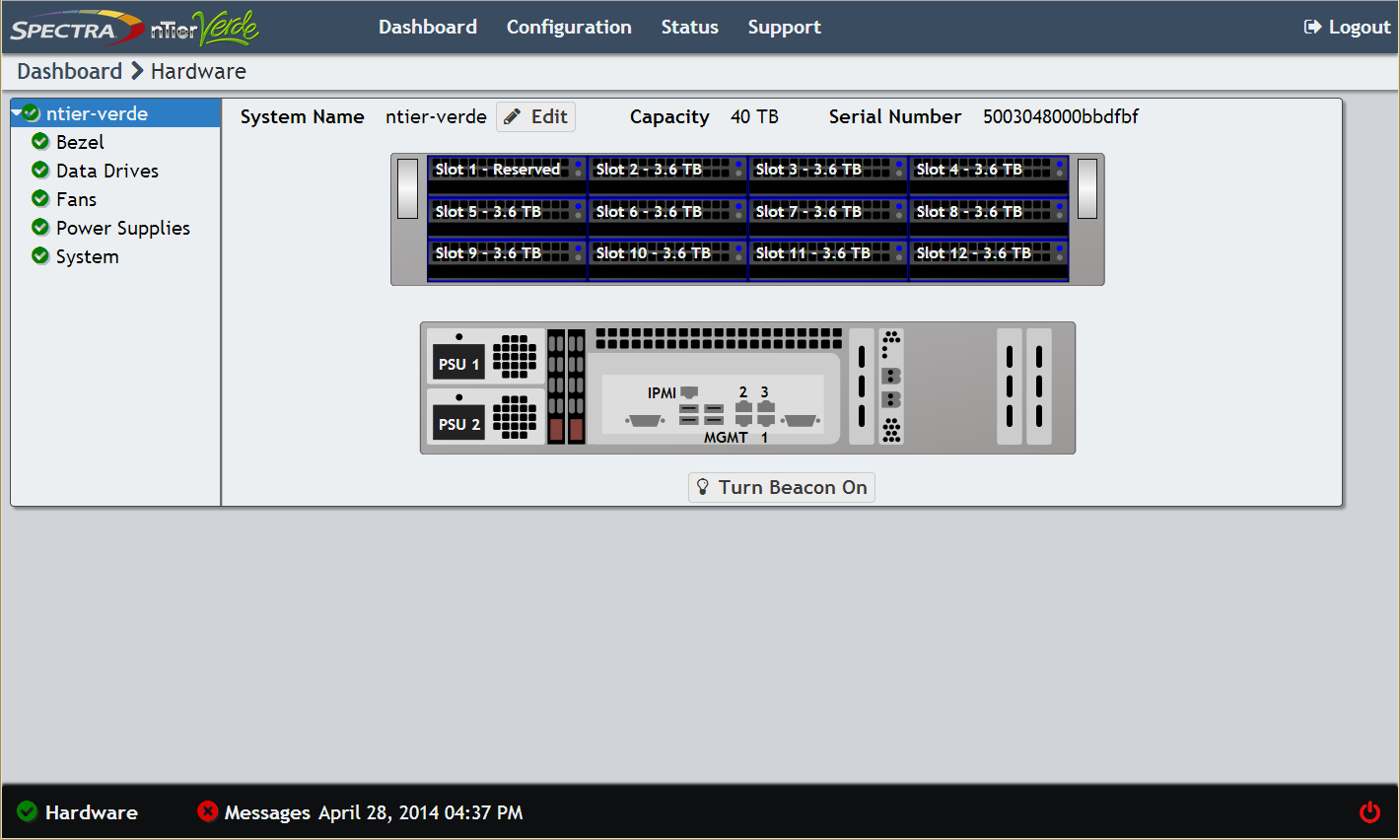
StrataView provides a basic status overview of hardware components
StrataView
The StrataView web interface looks a tad rudimentary but it's easy to use. The Dashboard provides a complete rundown on pools, volumes, shares and network ports along with performance graphs of selected pools and network ports alongside.
It shows a status view of all hardware components and issues alerts to multiple email addresses and to Spectra Logic support if faults are detected. You can generate reports ranging from storage status to network services and a handy feature is the direct links to all product documentation.
Conclusion
During testing we were impressed with the ease with which storage can be provisioned and the high levels of fault tolerance. The web interface is rather basic and expansion for the 2U nTier Verde is limited to one extra shelf but performance for CIFS shares is good and it supports optional 10GbE data links.
Verdict
The nTier Verde provides highly fault tolerant shared storage for data archiving and backup at a low price. The 2U model only supports one expansion shelf but storage is easy to provision and CIFS share performance is good.
Chassis: Supermicro 2U rack chassis
Motherboard: Supermicro X9DRD-7LN4F-JBOD
CPU: 2GHz Intel E5-2620 Xeon
Memory: 32GB DDR3
Storage: 2 x Seagate 250GB SFF SATA drives (OS); 6 x 4TB Hitachi 7.2K SAS drives (data)
RAID: Stripes, mirrors, single-, double- and triple-parity
Network: 4 x Gigabit (3 x data, 1 x management)
Expansion: Optional 10GbE PCI-e, SAS PCI-e expansion cards
Power: 2 x 920W hot-plug PSUs
Get the ITPro daily newsletter
Sign up today and you will receive a free copy of our Future Focus 2025 report - the leading guidance on AI, cybersecurity and other IT challenges as per 700+ senior executives
Dave is an IT consultant and freelance journalist specialising in hands-on reviews of computer networking products covering all market sectors from small businesses to enterprises. Founder of Binary Testing Ltd – the UK’s premier independent network testing laboratory - Dave has over 45 years of experience in the IT industry.
Dave has produced many thousands of in-depth business networking product reviews from his lab which have been reproduced globally. Writing for ITPro and its sister title, PC Pro, he covers all areas of business IT infrastructure, including servers, storage, network security, data protection, cloud, infrastructure and services.
-
 Google faces 'first of its kind' class action for search ads overcharging in UK
Google faces 'first of its kind' class action for search ads overcharging in UKNews Google faces a "first of its kind" £5 billion lawsuit in the UK over accusations it has a monopoly in digital advertising that allows it to overcharge customers.
By Nicole Kobie Published
-
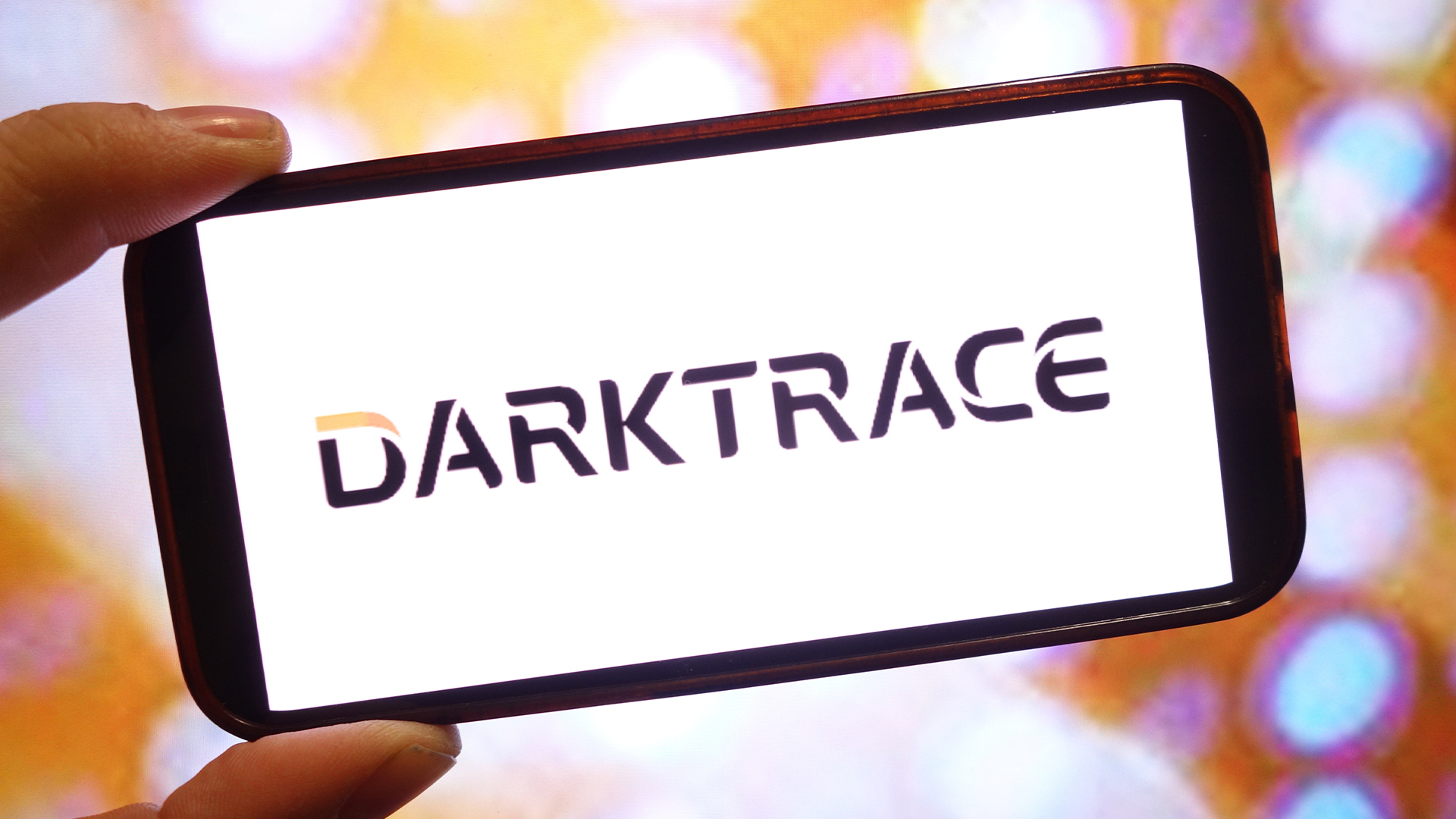 Darktrace unveils tailored AI models with a twist for its cybersecurity agent
Darktrace unveils tailored AI models with a twist for its cybersecurity agentNews Darktrace has announced new AI models for its agentic AI security tool, but it's taken a novel approach to tackle hallucinations.
By Rory Bathgate Published
-
 This tech company wants to pay staff to look after their mental and physical wellbeing
This tech company wants to pay staff to look after their mental and physical wellbeingNews Hot on the heels of its four-day week trial, tech company Thrive is offering staff new incentives to take care of their mental and physical wellbeing.
By Ross Kelly Published